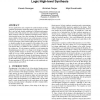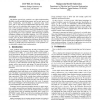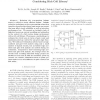GLVLSI
2000
IEEE
14 years 11 months ago
2000
IEEE
In many applications such as high-level synthesis (HLS) and logic synthesis and possibly engineering change order (ECO) we would like to get fast and accurate estimations of diffe...
DATE
2000
IEEE
14 years 11 months ago
2000
IEEE
Traditional FPGA design flows have treated logic synthesis and physical design as separate steps. With the recent advances in technology, the lack of information on the physical ...
DATE
2000
IEEE
14 years 11 months ago
2000
IEEE
Novel methodology and algorithms to seamlessly integrate logic synthesis and physical placement through a transformational approach are presented. Contrary to most placement algor...
ICCAD
2002
IEEE
14 years 11 months ago
2002
IEEE
The ultimate goal of logic synthesis is to explore implementation flexibility toward meeting design targets, such as area, power, and delay. Traditionally, such flexibility is exp...
FPGA
2004
ACM
15 years 7 days ago
2004
ACM
The cost functions used to evaluate logic synthesis transformations for FPGAs are far removed from the final speed and routability determined after placement, routing and timing a...
ASPDAC
2004
ACM
15 years 8 days ago
2004
ACM
— Reducing the ever-growing leakage power is critical to power efficient designs. Leakage reduction techniques such as power-gating using sleep transistor insertion introduces la...
ISQED
2005
IEEE
15 years 13 days ago
2005
IEEE
Abstract— Reliability enhancements are traditionally implemented through redundancies at the system level or through the use of harden-cell-designs at the circuit level. Reliabil...
GLVLSI
2005
IEEE
15 years 14 days ago
2005
IEEE
In this paper we develop a theory of equivalence checking (EC) and logic synthesis of circuits with a common specification (CS). We show that two combinational circuits N1, N2 have...
ASYNC
2005
IEEE
15 years 14 days ago
2005
IEEE
This paper proposes applying a logic synthesis approach to high level synthesis from SpecC specifications to timed asynchronous gate-level circuits. The state-based logic synthes...
GLVLSI
2006
IEEE
15 years 27 days ago
2006
IEEE
Most of the logic synthesis algorithms are not scalable for large networks and, for this reason, partitioning is often applied. However traditional mincut-based partitioning techn...



